独立主格结构+英语句子结构
独立主格结构

独立主格结构一、独立主格结构是一个名词或代词,加上一个形容词、副词、介词短语、分词、不定式等在句中作状语。
它有以下三个特点:1. 独立主格结构的逻辑主语与句子的主语不同,它独立存在。
2. 名词或代词与后面的形容词、副词、介词短语、分词、不定式等存在逻辑上的主谓关系。
3. 独立主格结构一般用逗号与主句分开,与主句之间不用任何连接词。
二、独立主格结构的常见形式1. 名词(代词)+现在分词(逻辑主语是分词的动作发出者)The moon appearing,they decided to go on with theirjouney.We shall play the match tomorrow, weather permitting. 明天假设天气好,我们就进行比赛。
2. 名词(代词)+过去分词(逻辑主语是分词的动作承受者)The job finished, we went home. 工作结束后我们就回家了。
Good-bye said,he went home.3. 名词(代词)+不定式Nobody to come tomorrow, we will have to put off the meeting till next week. 如果明天没有人来,我们将把会议推迟到下周。
So many people to help him, he is sure to succeed. 有如此多的人来帮助他,他一定会成功的。
4. 名词(代词)+介词短语(相当于不带动词的“主—系—介词短语)The soldiers dashed in, rifle in hand. 士兵们端着枪冲了进来。
A girl came in, book in hand. 一个少女进来了,手里拿着书。
5. 名词(代词)+形容词或副词(相当于一个未带动词的“主—系—表”结构)He sat in the front row, his mouth half open. 他坐在前排,嘴半开着。
英语独立主格结构讲解

英语独立主格结构讲解英语独立主格结构讲解独立主格结构是英语语法中的一种句子结构,用于突出或强调某一部分的信息。
它由一个名词、代词或动名词构成,加上一个修饰性的词或短语,被用来表达一个与主句相对独立的概念。
独立主格结构常常出现在独立的从句中,它可以提供额外的信息,强调特定的动作或状态。
独立主格结构的形式如下:名词/代词/动名词+ 修饰性词/短语。
下面是一些例句,用于解释和示范独立主格结构的用法:1. His arms folded, he stood there silently.(他双臂折叠,默默地站在那里。
)在这个例句中,"His arms folded"是独立主格结构,它突出了他折叠双臂的动作。
2. The sun shining brightly, we decided to go for a picnic.(阳光灿烂地照耀着,我们决定去野餐。
)"The sun shining brightly"是独立主格结构,它描述了阳光灿烂的状态。
3. The rain having stopped, they continued their journey.(雨停了,他们继续他们的旅程。
)"The rain having stopped"是独立主格结构,它表示雨已经停止的状态。
4. The baby crying in the crib, she rushed to comfort him.(婴儿在婴儿床上哭,她匆忙前去安慰他。
)"The baby crying in the crib"是独立主格结构,它描述了婴儿在婴儿床上哭的动作。
需要注意的是,独立主格结构在句子中通常是非限定性的,它与主句之间存在一定的解释或补充关系。
独立主格结构可以用逗号与主句分开,但也可以使用破折号或括号等标点符号来表示。
总而言之,独立主格结构是一种用于突出或强调特定动作或状态的句子结构。
独立主格与分词短语

独立主格与分词短语独立主格是英语语法中的一种句子结构,由一个名词(或代词)和一个动词的现在分词或过去分词构成,常用来表示同时发生的两个动作或描述动作的结果。
而分词短语是由动词的现在分词或过去分词构成的短语,能够作为句子的修饰部分,丰富句子内容。
独立主格的结构是:“名词(或代词)+动词的现在分词/过去分词”;而分词短语的结构则是“动词的现在分词/过去分词+其他成分”。
下面将分别介绍独立主格与分词短语的用法和例句:独立主格用法:1. 描述两个并行动作:当两个动作同时发生,且彼此相互独立时,可以使用独立主格。
例如:- 他站在窗边,望着远方夕阳西下。
- 这个问题解决了,我们可以放心了。
2. 描述动作的结果:通过使用独立主格,可以表达动作产生的结果或效果。
例如:- 天空阴沉沉的,风吹得树叶瑟瑟作响。
- 听到好消息,他高兴地笑了起来。
分词短语用法:1. 修饰名词:分词短语可以作为形容词,修饰名词或代词。
例如:- 坐在街边的那个女孩正在读一本书。
- 那个弄脏了衣服的男孩是我的朋友。
2. 修饰句子:分词短语也可以修饰整个句子,相当于一个独立的动作或状态。
例如:- 跑着进屋,他大声喊道:“我回来了!”- 乘坐旅游巴士,他们欣赏着窗外美景。
需要注意的是,独立主格和分词短语都是非限定性短语,在句中一般用逗号与主句分开。
此外,使用独立主格和分词短语能够使句子更加丰富多样,增加句子的表达力。
总结:独立主格和分词短语是英语中常见的句子结构和修饰成分。
独立主格常用于表达两个并行动作或动作结果;而分词短语常用于修饰名词或整个句子。
它们的灵活运用可以使句子更加生动、丰富,提升文章的表达效果。
(字数:509)。
独立主格结构和分词结构的区别

独立主格结构和分词结构的区别在英语语法中,独立主格结构和分词结构是两种常见的语法结构。
尽管它们在形式上比较相似,但在用法和含义上存在一些显著的区别。
本文将对独立主格结构和分词结构进行详细介绍,并比较它们之间的异同点。
一、独立主格结构独立主格结构是由独立主格和谓语构成的句子结构,独立主格由名词或代词构成,位于主句之前。
它的作用是对整个句子中的动作或状态进行进一步解释或声称。
独立主格结构的构成:名词/代词 + 分词/形容词/副词等例句:1. 他们站在门口,皮肤晒得黝黑。
(名词 + 形容词)2. 我和姐姐争吵过后,心情变得沮丧。
(代词 + 分词)3. 他离开公司,失业已经有两个月了。
(名词 + 分词)4. 天气变冷,他的手开始发抖。
(名词 + 形容词)5. 他们全神贯注地听着教授的讲课。
(代词 + 副词)独立主格结构的特点:1. 独立主格结构与主句之间用逗号隔开。
2. 它可以用在句首或句末,但大部分情况下放在句首。
3. 独立主格中的名词或代词通常是指句子主语的人或事物。
4. 独立主格结构不会影响句子的主谓结构。
二、分词结构分词结构是由分词(动词的现在分词或过去分词形式)加上修饰成分构成的结构。
它可以修饰名词或代词,表示该名词或代词的状态、特征或所处的位置等。
分词结构的构成:分词 + 修饰成分例句:1. 我看到他走在街上。
(现在分词)2. 这是我买的新书。
(过去分词)3. 坐在那里的女孩是我的朋友。
(现在分词)4. 穿着红色连衣裙的是我的姐姐。
(现在分词)5. 坐在教室后排的学生都很安静。
(现在分词)分词结构的特点:1. 分词结构修饰前面的名词或代词,起形容词的作用。
2. 分词可以是现在分词(-ing形式)或过去分词(-ed形式)。
3. 分词结构可以放在被修饰词的前面或后面。
4. 分词结构与被修饰词之间没有逗号隔开。
区别:1. 构成差异:独立主格结构由名词或代词加上分词/形容词/副词等构成,而分词结构则是由分词加上修饰成分构成。
独立主格结构和分词结构
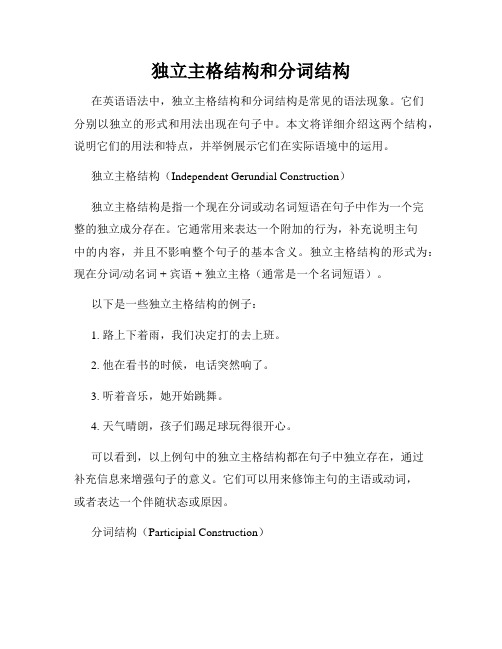
独立主格结构和分词结构在英语语法中,独立主格结构和分词结构是常见的语法现象。
它们分别以独立的形式和用法出现在句子中。
本文将详细介绍这两个结构,说明它们的用法和特点,并举例展示它们在实际语境中的运用。
独立主格结构(Independent Gerundial Construction)独立主格结构是指一个现在分词或动名词短语在句子中作为一个完整的独立成分存在。
它通常用来表达一个附加的行为,补充说明主句中的内容,并且不影响整个句子的基本含义。
独立主格结构的形式为:现在分词/动名词 + 宾语 + 独立主格(通常是一个名词短语)。
以下是一些独立主格结构的例子:1. 路上下着雨,我们决定打的去上班。
2. 他在看书的时候,电话突然响了。
3. 听着音乐,她开始跳舞。
4. 天气晴朗,孩子们踢足球玩得很开心。
可以看到,以上例句中的独立主格结构都在句子中独立存在,通过补充信息来增强句子的意义。
它们可以用来修饰主句的主语或动词,或者表达一个伴随状态或原因。
分词结构(Participial Construction)分词结构是通过分词的形式在句子中充当句子成分的一种短语结构。
分词结构可以是现在分词(-ing形式)或过去分词(-ed或第三人称单数形式)。
分词结构常常用来修饰主语或宾语,并且能够形成定语从句或状语从句。
以下是一些分词结构的例子:1. 坐在沙发上,他看着电视。
2. 这本书是由著名作家写的。
3. 受伤的狗躺在路边。
可以看到,以上例句中的分词结构分别修饰了主语、宾语和介词短语,使得句子更加丰富和详细。
分词结构可以用来表达时间、原因、条件、方式、伴随等多种语义。
总结独立主格结构和分词结构是英语语法中常见的句子结构形式。
独立主格结构通过现在分词/动名词短语的形式在句子中独立存在,补充说明主句中的内容。
而分词结构则通过分词的形式修饰主语或宾语,起到进一步详细描述的作用。
这两个结构都能为句子增添信息,使其更加准确和丰富。
在实际应用中,我们可以根据句子的需要灵活运用独立主格结构和分词结构,以达到精准表达的目的。
独立主格结构+英语句子结构
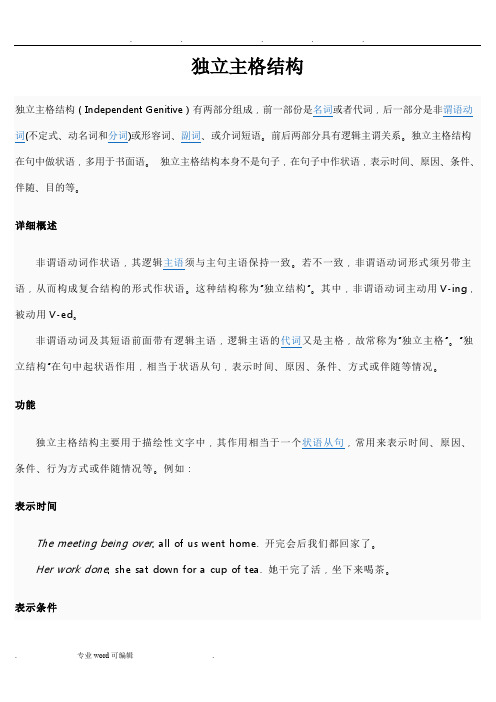
独立主格结构独立主格结构(Independent Genitive)有两部分组成,前一部份是名词或者代词,后一部分是非谓语动词(不定式、动名词和分词)或形容词、副词、或介词短语。
前后两部分具有逻辑主谓关系。
独立主格结构在句中做状语,多用于书面语。
独立主格结构本身不是句子,在句子中作状语,表示时间、原因、条件、伴随、目的等。
详细概述非谓语动词作状语,其逻辑主语须与主句主语保持一致。
若不一致,非谓语动词形式须另带主语,从而构成复合结构的形式作状语。
这种结构称为“独立结构”。
其中,非谓语动词主动用V-ing,被动用V-ed。
非谓语动词及其短语前面带有逻辑主语,逻辑主语的代词又是主格,故常称为“独立主格”。
“独立结构”在句中起状语作用,相当于状语从句,表示时间、原因、条件、方式或伴随等情况。
功能独立主格结构主要用于描绘性文字中,其作用相当于一个状语从句,常用来表示时间、原因、条件、行为方式或伴随情况等。
例如:表示时间The meeting being over, all of us went home. 开完会后我们都回家了。
Her work done, she sat down for a cup of tea. 她干完了活,坐下来喝茶。
表示条件The condition being favourable, he may succeed. 若条件有利,他或许能成功。
表示原因There being no taxes, we had to walk. 没有出租车,我们只好步行。
He wrapped her up with great care, the night being dark and frosty. 夜又黑又冷,所以他把她裹得严严实实的。
表示伴随情况Almost all metals are good conductors, silver being the best of all. 几乎所有的金属都是良导体,而银则是最好的导体。
独立主格结构英语句子结构

独立主格结构独立主格结构(Independent Genitive)有两局部组成,前一部份是或者代词,后一局部是非(不定式、动名词和)或形容词、、或介词短语.前后两局部具有逻辑主谓关系.独立主格结构在句中做状语,多用于书面语.独立主格结构本身不是句子,在句子xx状语,表示时间、原因、条件、伴随、目的等.详细概述非谓语动词作状语,其逻辑须与主句主语保持一致.假设不一致,非谓语动词形式须另带主语,从而构成复合结构的形式作状语.这种结构称为〃独立结构〃.其中,非谓语动词主动用V・ing,被动用V-ed.非谓语动词及其短语前面带有逻辑主语,逻辑主语的又是主格,故常称为〃独立主格〃.〃独立结构〃在句中起状语作用,相当于状语从句,表示时间、原因、条件、方式或伴随等情况.功能独立主格结构主要用于描绘性文字中,其作用相当于一个,常用来表示时间、原因、条件、行为方式或伴随情况等.例如:表示时间The meeting being over, all of us went home,开完会后我们都回家了.Her work done, she sat down for a cup of tea.她干完了活, 坐下来喝茶.表示条件The condition being favourable, he may succeed.假设条件有利,他或许能成功.表示原因There being no taxes, we had to walk,没有出租车,我们只好步行.1 / 15He wrapped her up with great care, the night being dark and frosty. 夜又黑又冷,所以他把她裹得严严实实的.表示伴随情况Almost all metals are good conductors, silver being the best of all. 几乎所有的金属都是良导体,而银那么是最好的导体.(=Almost all metals are good conductors, and silver is the best of all.)用法独立主格结构主要表示发生的时间、原因、条件或伴随情况等,相当于一个状语从句或并列句.用作时间状语The work done(=After the work had been done), we went home. 1:作完成后, 我们就回家了.用作条件状语Weather permitting(=lf weather permits), they will go on an outing to the beach tomorrow.如果天气允许的话,他们将在明天组织一次xx小游.用作原因状语An important lecture to be given tomorrow(=As an important lecture will be given tomorrow), the professor has to stay up late into the night. 由于明天要发表一个重要的演讲,教授不得不熬夜到很晚.用作伴随状语He was lying on the grass,his hands crossed under his head(=and his hands were crossed under his head),他躺在草地上,两手交叉枕在脑后.表示补充说明2/15We redoubled our efforts, each man working like two.我们加倍努力,一个人干两个人的活.*注:独立主格结构表示时间、条件或原因时,相当于一个状语从句,一般放在句首,表示原因时还可放在句末;表伴随状况或补充说明时,相当于一个并列句,通常放于句末.形式1> 一般独立主格形式:与主句逻辑关系松散形式为:n. + -ed/-ing形式;n. +不定式;n. +; n. + ; n. +副词.;名词/主格代词+现在分词名词/主格代词与之间是主谓关系.如:The girl staring at him(= As the girl stared at him), he didn't know what to say. 姑娘两眼望着他,他不知道说什么好.Time permitting(= If time permits), we will go for an outing tomorrow. 如果时间允许的话,我们明天去郊游.名词/主格代词+过去分词名词/主格代词与过去分词之间是动宾关系.如:The problems solved(= As the problems were solved), the quality has been improved.随着问题的解决,质量已经提升了.Her glasses broken(= Because her glasses were broken), she couldn't see the words on the blackboard,由于眼镜摔坏了,她看不见黑板上的字.名词/主格代词+不定式名词/主格代词与不定式之间是主谓关系,且强调的是一次具体性的动作. 如:3/15He is going to make a model plane, some old parts to help. 借助于一些I日零件,他要做一个飞机模型.They said good-bye to each other, one to go home, the other to go to the bookstore.他们道别后,一个回了家,一个去了书店.名词/主格代词+形容词如:An air accident happened to the plane,nobody alive.那架飞机遭遇了空难,无一人生还.So many people absent, the meeting had to be called off,这么多人缺席,会议不得不取消.名词/主格代词+副词如:He put on his sweater,wrong side out,他把毛衣穿反了.The meeting over, they all went home.会议一结束,他们就都回家了.名词/主格代词+介词短语如:The boy goes to the classroom,book in hand,那男孩手里拿着书去教室.Mary was sitting near the fire, her back towards the door.靠近火炉坐着,背对着门.2>with引导的独立主格:与主句逻辑关系紧密形式为:with + n. + -ed/-ing 形式;with + n. +abj.; with +n. + 介词短语3>each引导的强调型独立主格:尾的复数名词4/15形式为:句子+复数名词结尾,each +介词短语/形容词短语/名词短语/・ing 形式/-ed形式如:4>其他形式There being +名词〔代词〕如:There being nothing else to do, we went home.没有别的事可做,我们就回家了.There being no further business, I declare the meeting closed. 没有再要讨论的事了,我宣布散会.It being +名词〔代词〕如:It being Christmas, the government offices were closed. 由于圣诞节的缘故, 政府机关都休息.It being a holiday, all the shops were shut,由于今天是,所有商店都关门了.特点1〕独立主格结构的与句子的主语不同,它独立存在.2〕名词或代词与后面的,形容词,副词,不定式,等是主谓关系.3〕独立主格结构一般有逗号与主句分开.举例:The test finished, we began our holiday.=When the test was finished, we began our holiday.5/15测试结束了,我们开始放假.The president assassinated, the whole country was in deep sorrow.=After the president was assassinated, the whole country was in deep sorrow.总统被谋杀了,举国上下沉浸在悲哀之中.Weather permitting, we are going to visit you tomorrow.如果天气允许,我们明天去看你.This done, we went home.工作完成后,我们才回家.The meeting gone over, everyone tired to go home earlier.会议结束后,每个人都想早点回家.He came into the room,his ears red with cold.他回到了房子里,耳朵冻坏了.He came out of the library, a large book under his arm.他夹着本厚书,走出了图书馆注:独立主格结构有时可在其前加上介词with.如:Don't sleep with the windows open.别开着窗睡觉.He was lying on the bed with all his clothes on.他和衣躺在床上.She came in with a book in her hand,她手里拿着一本书走了进来.He fell asleep with the lamp burning.他没熄灯就睡着了.I won't be able to go on holiday with my mother being il 由于妈妈有病,我无法去度假.6/15He sat there with his eyes dosed,他闭目坐在那儿.All the afternoon he worked with the door locked.整个下午他都锁着门在房里工作.I can't go out with all these clothes to wash.要洗这些衣服,我无法出去了.考前须知1•独立主格与状语从句的转换当状语从句的主语与主句的主语不是指同一个对象时,可用独立主格结构取代状语从句,但不再保存连词.如:After class was over (=Class being over / Class over), the students soon left the classroom.卜课后,学生很快离开了课室.2.不能省略being (having been)的情形:在以下两种情况下,独立主格结构中的being (或having been)不能省略.(1)独立主格的逻辑主语是代词时.如:It being Sunday, we went to church. 由于是星期天,我们去了做礼拜.(2)在There being+名词的结构中.如:There being no bus, we had to go home on foot.由于没有公共汽车,所以我们不得不步行回家.3.在〃名词(或代词)+介词短语〃构成的独立主格结构中,一般不用和冠词.如:Miss Smith entered the classroom, book in hand.xx 走进了课室,手里拿着一本书.比拟with 的复合结构.如:Miss Smith entered the classroom, with a book in her hand.4.独立主格结构没有所有格形式The chief-editor arriving, we began the meeting.主编来了,我们开始开会.(比拟复合结构.)例如请看下面一道题:Not far from the school there was a garden,owner seated in it playing chess with his little grandson every afternoon.7 / 15A. itsB. whoseC. whichD. that【分析】此题很容易误选B,许多同学会认为句中逗号后是一个非限制性的,whose在定语从句中用作定语修饰其后的名词owner.此分析从外表上看,似乎天衣无缝,但实质上是错的,原因是空格后根本不是一个句子,由于没有谓语.尽管句中有两个动词,但它们都是非谓语动词.也许有的同学认为,其中的seated可视为谓语动词,但是注意,seat用作动词时,它总是及物的,其后要么接,要么它就用于,所以假设在seated前加上助动词is,那么可以选择B (当然假设将seated改为sitting,也应选择A).所以此题最正确答案选Ao请再看一个类似的例子:(1)He wrote a lot of novels, many of translated into foreignlanguages.A. itB. themC.whichD. that(2)He wrote a lot of novels, many of were translated into foreignlanguages.A. it B. them C. which D. that第⑴应选B,而不能选C,是由于句中的translated是过去分词(非谓语动词),假设选C,那么该从句无谓语;第⑵应选C,该句是典型的,由于该句修饰的是前面的novels,即指物,所以只能用which做of的宾语,故此题选C.再请看下面一例:(3)He wrote a lot of novels, and many of were translated intoforeign languages.A. itB. themC. whichD. that【分析】此题与上面的第⑵题不同,两句间多了一个并列连词and,说明这是一个并列句,故应选B,那么不能选C.请做做以下三题(答案均为B):8/15(1)There I met several people, two of being foreigners.〔独立主格结构〕A. whichB. themC. whomD. that(2)There I met several people, two of were foreigners.〔非限制性定语从句〕A. whichB. whomC. whoD. that(3)There I met several people, and two of were foreigners.〔两个句子〕A. whichB. themC. whomD. that英语句子结构一.简单句:英语句子看上去纷繁庞杂,但仔细观察不外乎五个根本句式. 这五个根本句式可以演变出多种复杂的英语句子.换言之,绝大多数英语句子都是由这五个根本句式生成的.这五个根本句式如下:S十V主谓结构S十V十P主系表结构S十V十.主谓XX结构S十V十.1十.2主谓xx结构S十V十.主谓xx结构说明:S=主语;V=谓语;P =表语;O=xx语;.1 =间接xx语;02 =直接xx语;C=xx语补足语五个根本句式详细解释如下:LS十V句式在此句式中,V是不及物动词,又叫自动词〔vi.例如:9/15He runs quickly.他跑得快.They listened carefully.他们听得很仔细.He suffered from cold and hunger.他挨冻受饿.China belongs to the third world country. xx 属于第三世界国家. The gas has given out.煤气用完了.My ink has run out.我的钢笔水用完了.S十V十P句式The story sounds interesting.这个故事听起来有趣.The desk feels hard.书桌摸起来很硬.The cake tastes nice.饼尝起来很香.The flowers smell sweet and nice. 花闻起来xx.You have grown taller than before.你长得比以前高了.He has suddenly fallen ill.他忽然病倒了.He stood quite still.他静静地站看.He could never turn traitor to his country.他永远不会背叛他的祖国.注意:有些动词同时也是及物动词,可构成SVO句式,例如:He looked me up and down.他上下打量我.He reached his hand to feel the elephant.他伸出手来摸象.They are tasting the fish.他,们在品尝鱼.They grow rice in their home town.他们在家乡种水稻.10 /15He's got a chair to sit on.他有椅子坐.Please turn the sentence into English. 请把这个句xx 英语.3.S十V十.句式在此句式中,V是及物动词(vt.),因此有宾语.例如:I saw a film yesterday.我昨天看了一部电影.Have you read the story?你读过这个故事吗?They found their home easily.他们很容易找到他们的家.They built a house last year.他们去年建了一所房子.They've put up a factory in the village.他们在村里建了一座工厂.They have taken good care of the children.这些孩子他们照看得很好.You should look after your children well.你应该好好照看你的孩子.4.S十V十.1十02句式在此句式中,V是带有双宾语的及物动词.常见的须带双宾语的动词有give, ask, bring, offer, send, pay, lend, show, tell, buy, get; rob, warn 等.例如:He gave me a book/a book to me.他给我一本书.He brought me a pen/a pen to me.他带给我一枝钢笔.He offered me his seat/his seat to me.他把座位让给我.注意下边动词改写后介词的变化:Mother bought me a book/a book for me.妈妈给我买了一本书.He got me a chair/a chair for me.他给我弄了一把椅子.11 / 15Please do me a favor/a favor for me. 请帮我一下.He asked me a question/a question of me. 他问我个问题.注意,下边动词只有一种说法:They robbed the old man of his money.他们抢了老人的钱.He's warned me of the danger,他警告我注意危险.The doctor has cured him of his disease.医生治好了他的病.We must rid the house of the rats.我们必须赶走屋里的老鼠.They deprived him of his right to speak.他们剥夺了他说话的权利.5.S十V十.句式在此句式中,V是有宾语补足语的及物动词.常带宾语补足语的词有形容词、副词、介词短语、名词、不定式、现在分词、过去分词常见的可接宾语补足语的动词很多,哪些动词可接哪几种形式作宾补,须根据动词的惯用法而定,不能统而概论.请看下面的例子.They made the girl angry.他们使这个女孩生气了.They found her happy that day.他们发现那天她很快乐.I found him out.我发现他出去了.I saw him in.我见他在家.They saw a foot mark in the sand.他们发现沙地上有脚印.They named the boy Charlie.他们给这个男孩起名为查理.They felt the car moving fast.他们感到汽车行驶得很快.I heard the glass broken just now.我刚刚听到玻璃碎了.12 /15He found the doctor of study closed to him.他发现研究所的大门对他关闭了.英语的并列句一般情况下引不起巨大的阅读障碍,由于在分句之间往往有固定的连接词说明前后分句的关系.这样的连接词有以and为代表的表示意义延伸的并列连词、以.r为代表的表示选择概念的并列连词、以but为代表的表示转折的并列连词和表示原因的for四个类型.第一种包括and, not only ... but (also )..., neither ( nor).第二种包括or, either …or …;第三种包括but, while, whereas等.第四种只有一个for.对此我们分别举一个例句说明问题:(l)As is reported, a trade agreement was signed and a cultural exchange was arranged.(2)Not only is he himself interested in the subject but all his students are beginning to show an interest in it.(3)Dr. Fisher neither loves the environment, nor is he accustomed to the weather.(4)The children can go with us, or they can stay at home.(5)You can either go it by yourself, or you can ask someone else to do it.(6)The young man has often been praised, but he is never conceited.(7)While our country has plenty of oil, theirs has none.(8)They want to live in town, whereas we would rather live in the country.(9)They apparently have a good drainage system, for the streets never seem to flood after a downpour.有必要说明的是以上的关联词并非只能有一个含义,比方and就可以表示意义增补、动作先后、转折或让步、条件和结果等等一些用法.这里笔者只是提醒大家区分从句,所以这方面的语言知识请参考相关的语法书.13 / 15另外我们还应该把并列分句和并列结构(coordinate construction)区分开来. 并列结构是由并列连词或者其他并列手段例如标点符号连接起来的语法结构序列,它包括并列分句,也包括并列的词或者词组.3、附属句构成附属关系的复杂句包括名词性分句(Nominal Clauses)(可以作主语、宾语、同位语、主语补语)、关系分句(Relative Clauses)、状语分句(Adverbial Clauses) o对于它们的连接词,在相应的语法书上都不难找到,这里就不再多讲了.需要提醒读者的是,在判定句子的类型之后,最主要的工作就是分析简单句的成分,找到主句的谓语,真正抓住句子的纲领.下面请作练习二,首先识别多重分句的类型,然后找出主句和附属分句的谓语.Laboratory scientists accustomed to noticing subtle changes in the properties of substances they are investigating are doubtless better than you or I at certain sorts of observations.这里的主语是Laboratory scientists,但是后面跟了一个过去分词定语,其中分词中的介词又跟了一个-ing形式,-ing形式后又接了一个宾语和一个带有定语的状语.本句的谓语是are doubtless better than o4 •英语的信息末端原那么的应用在英语中,信息含量大的局部往往出现在句子的末尾.这个特点一方面造就了一些非正常语序的句子,另一方面可以给我们提供线索,帮助我们正确理解英语中的长句.我们知道,一个信息发出者要表达丰富的信息,离开从句是寸步难行的.可是不管句子结构多么复杂,根本的句型还是只有五种.下面我们可以通过逐一的分析,探讨英语难句形成的规律.对于SV结构,由于英语句子一般是末尾的信息含量大,所以这种句子往往难以构成阅读困难,至多是主语位置有定语从句或者同位语从句.例如:(例子).SVO 结构的难点在于主语和宾语都可以连接定语从句;SVC结构也难以构成较复杂的句子;SVOC结构如果出现长句,那么往往是补语被调整到宾语的前面;SV..结构也要注意哪个是直接宾语,哪个是间接宾语.14 / 15SVOC: People often let their fear of speaking up and appearing more dull- witted than their peers interfere with their understanding.Derived from theoretical considerations and confirmed by observations, the velocity-distance law has made secure the concept of an expanding universe.下面请做练习,识别主句的根本类型.1.They would find relevant the antislavery attitudes of Northerners during the colonial period, the conflict over slavery in the Constitutional Convention, the Missouri Compromise, the militant abolitionist movement of the 1830, and the Compromise of 1850.2.The study made clear that the working class that is so over-represented in crime statistics consists of lower-class people living in the lower-class areas of large cities.from the People's Daily on current affairs in .15 /15。
独立主格

一、独立主格结构的形式英语中,独立主格结构的形式是:名词或代词跟形容词、副词、介词短语、非谓语动词连在一起,构成独立主格结构。
1.名词/ 代词+ 不定式。
如:A house to be built, we must save every cent. 由于要建一座房子,我们必须节省每一分钱。
Now here is Li Lei, Wei Fang to come tomorrow. 现在李蕾来了,魏方明天到。
2.名词/ 代词+ -ing分词。
如:The bus coming here soon, we should get everything ready. 汽车很快就要来了,我们应该把一切事情准备好。
Mother being ill, Li Lei was very worried. 母亲病了,李蕾非常焦急。
3.名词/ 代词+ 动词的过去分词。
如:His cup broken, he used his bowl instead. 茶杯破了,他就用碗来代替。
4.名词/ 代词+ 形容词。
如:The ground muddy, we should be careful. 地面泞泥,我们应该小心。
5.名词/ 代词+ 副词。
如:The class over, we all went out to play. 下课后,我们都出去玩。
6.名词/ 代词+ 介词短语。
如(from ):Glasses in his hand, he asked where his glasses were. 手里拿着眼镜,他问他的眼镜哪去了。
二、独立主格结构的句法功能独立主格结构在句子中作状语,表示时间、原因、条件和伴随等情况。
1.作时间状语School over, the students went home. 放学后,学生们都回家了。
The ceremony ended, the games began. 仪式结束后,比赛开始了。
英语中的独立主格结构归纳

英语中的独立主格结构归纳非谓语动词作状语时,它的逻辑主语应该是句子的主语。
但有时非谓语动词带有自己的主语,从而在结构上与主语不发生关系,我们称之为独立主格结构(Absolute Construction)。
其实,所谓“独立主格结构”也并非真正独立,它还是一种从属的结构。
一、非谓语动词独立主格结构在独立主格结构中,非谓语动词和它前面的名词或代词存在着逻辑上的主谓关系。
Such an able man to help you,you will surely succeed sooner or later.有这么能干的人来帮你, 你迟早一定会成功的。
(such an able man和to help you 之间存在着主谓关系)= Since such an able man will help you, you will surely succeed sooner or later.He seating himself at the desk, his mother began to tell him a story.他在书桌旁坐好后,他母亲开始给他讲故事。
(seating himself at the desk拥有了自己的逻辑主语he,注意是“主格”)= When he seated himself at the desk, his mother began to tell him a story.The key to the bike lost, he had to walk to school.由于丢了自行车钥匙,他只好步行去学校。
(lost 的逻辑主语是the key,lost 也可以用完成式having been lost)= Because the key to the bike had been lost, he had to walk to school.A.不定式“独立主格结构”在“逻辑主语+动词不定式”结构中,动词不定式和它前面的名词或代词存在着逻辑上的主谓关系。
英语 独立主格结构

• 名词+介词短语 • 1)The mayor of Hiroshima strode at a leisure pace toward the puzzled journalist,a bunch of flowers in his hands.(广岛市市长双手捧着 一束鲜花,迈着方步走向那个迷惑不解的记者。) 2)Every afternoon a very old woman hobbled past the ramshackle house,a vast load of firewood on her back.(每天下午,一个背着 一大背柴禾的老妇人都会从那间东倒西歪的房屋 前蹒跚着走过。)
名词+不定式 His mother to come tonight,he is busy preparing the dinner. 他母亲今晚要来,他正在忙着准备饭菜。 The four of us agreed on a division of labour,each to translate a quarter of the book.我们四人同意分 工干,每人翻译全书的四分之一。 Many trees,flowers,and grass to be planted,our newly-built school will look even more beautiful. 种上许多的树,花和草后,我们新 建的学校将看上去更美。
• 原因状语 • 1)The storm drawing near,the navvy decided to call it a day. • 2)The Cossack being intent on his stalking, his foot touched the protruding bough that was the trigger.
英语中的独立句子是什么意思
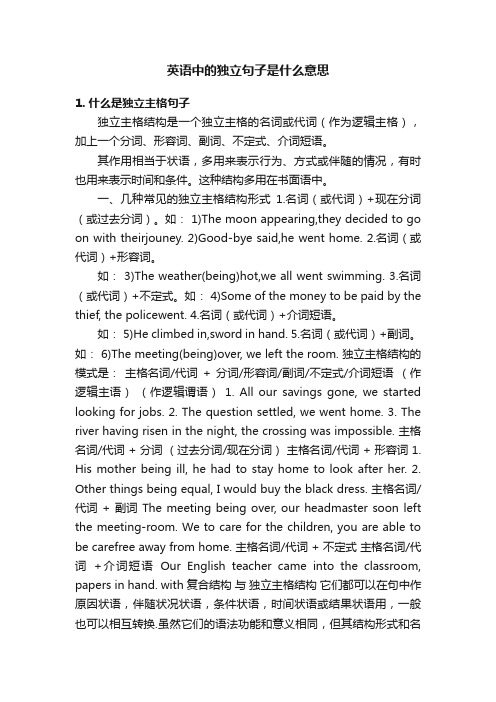
英语中的独立句子是什么意思1. 什么是独立主格句子独立主格结构是一个独立主格的名词或代词(作为逻辑主格),加上一个分词、形容词、副词、不定式、介词短语。
其作用相当于状语,多用来表示行为、方式或伴随的情况,有时也用来表示时间和条件。
这种结构多用在书面语中。
一、几种常见的独立主格结构形式1.名词(或代词)+现在分词(或过去分词)。
如: 1)The moon appearing,they decided to go on with theirjouney. 2)Good-bye said,he went home. 2.名词(或代词)+形容词。
如: 3)The weather(being)hot,we all went swimming. 3.名词(或代词)+不定式。
如: 4)Some of the money to be paid by the thief, the policewent. 4.名词(或代词)+介词短语。
如: 5)He climbed in,sword in hand. 5.名词(或代词)+副词。
如: 6)The meeting(being)over, we left the room. 独立主格结构的模式是:主格名词/代词+ 分词/形容词/副词/不定式/介词短语(作逻辑主语)(作逻辑谓语)1. All our savings gone, we started looking for jobs. 2. The question settled, we went home. 3. The river having risen in the night, the crossing was impossible. 主格名词/代词 + 分词(过去分词/现在分词)主格名词/代词 + 形容词 1. His mother being ill, he had to stay home to look after her. 2. Other things being equal, I would buy the black dress. 主格名词/代词 + 副词 The meeting being over, our headmaster soon left the meeting-room. We to care for the children, you are able to be carefree away from home. 主格名词/代词 + 不定式主格名词/代词+介词短语Our English teacher came into the classroom, papers in hand. with复合结构与独立主格结构它们都可以在句中作原因状语,伴随状况状语,条件状语,时间状语或结果状语用,一般也可以相互转换.虽然它们的语法功能和意义相同,但其结构形式和名称却不相同. with复合结构的模式是: with+名词/代词+分词/形容词/副词/不定式/介词短语独立主格结构的模式是:主格名词/代词+分词/形容词/副词/不定式/介词短语一,作时间状语1,With winter coming on, the trees turn yellow and some birds fly south. =Winter coming on, the trees turn yellow and some birds fly south. 二,作原因状语1,With the weather terribly cold, we entered the room to warm ourselves. = The weather terribly cold, we entered the room to warm ourselves. 2,With the key having been lost, she could not enter the room. = The key having been lost, she could not enter the room. 三,作条件状语 1,With time permitting, we'll visit the Summer Palace. = Time permitting, we'll visit the Summer Palace. 2,With the car going wrong, we'll have to stop at the foot of the mountain. = The car going wrong, we'll have to stop at the foot of the mountain. 四,作伴随状语 1,The mother was cleaning the house with her baby playing on the bed. =The mother was cleaning the house, her baby playing on the bed. 2,Last night I followed him, with a sword in my hand. = Last night I followed him , sword in hand. 无论with复合结构还是独立主格结构,都不可有动词的谓语形式充当其中的逻辑谓语.如下例中的was就必须去掉: He sat at the desk reading with a pen was in his right hand. with复合结构可以作后置定语修饰名词,而独立主格结构则不可作后置定语修饰名词. Soon she arrived at a park with grass green and flowers in blossom. = Soon she arrived at a park whose grass was green and whose flowers were in blossom.。
英语独立主格结构
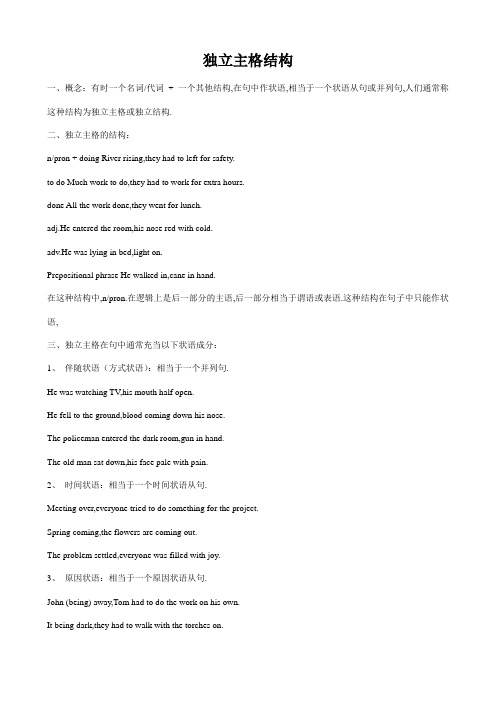
独立主格结构一、概念:有时一个名词/代词+ 一个其他结构,在句中作状语,相当于一个状语从句或并列句,人们通常称这种结构为独立主格或独立结构.二、独立主格的结构:n/pron + doing River rising,they had to left for safety.to do Much work to do,they had to work for extra hours.done All the work done,they went for lunch.adj.He entered the room,his nose red with cold.adv.He was lying in bed,light on.Prepositional phrase He walked in,cane in hand.在这种结构中,n/pron.在逻辑上是后一部分的主语,后一部分相当于谓语或表语.这种结构在句子中只能作状语,三、独立主格在句中通常充当以下状语成分:1、伴随状语(方式状语):相当于一个并列句.He was watching TV,his mouth half open.He fell to the ground,blood coming down his nose.The policeman entered the dark room,gun in hand.The old man sat down,his face pale with pain.2、时间状语:相当于一个时间状语从句.Meeting over,everyone tried to do something for the project.Spring coming,the flowers are coming out.The problem settled,everyone was filled with joy.3、原因状语:相当于一个原因状语从句.John (being) away,Tom had to do the work on his own.It being dark,they had to walk with the torches on.There being no bus,they had no choice but to take a taxi.4、条件状语:相当于一个条件状语从句.Weather permitting,we’ll have a picnic this Sunday.Enough time given,we’ll do the job better.注:有时可以在独立主格前面加上介词with,构成with +复合宾语结构.如:With the problem settled,the computer restarted.With the old man leading,we had no difficulty finding the old Red Army man’s house.You should not speak to others with your mouth full of food.He left the bathroom,with the water running.He rushed out with a knife in his hand.此句可改写为He rushed out ,a knife in his hand.或He rushed out,knife in hand.但是,“with + 复合宾语”结构也可以用作定语.如:Soon they found themselves walking in a valley with high mountains around it.He lives in a village with a railway behind it.Harry Potter is a boy with a scar on his forehead.。
独立主格结构

独立主格结构独立主格结构是英语中一种常见且有特殊用法的句子结构。
它由一个名词或代词作为独立主格,加上一个动词的现在分词构成。
在句子中,独立主格结构可以作为一个独立的分句,起到强调、补充说明、描述主要动作的副作用等作用。
独立主格结构的主要特点是,该结构与主句没有主谓关系,它的动词形式是现在分词形式,表示动作与主句的动作几乎同时发生,但和主句动作之间没有因果关系。
以下是一些例子来解释独立主格结构的用法和作用。
例子1:- 英文原句:The children playing in the park were laughing happily.- 中文翻译:在公园里玩耍的孩子们正在开心地笑着。
- 解释:在这个例子中,"playing in the park"是独立主格结构,独立地描述了孩子们的动作,即他们在公园里玩耍。
这个独立主格结构起到了补充说明的作用,使整个句子更加生动。
例子2:- 英文原句:The rain stopped, the sun coming out from behind the clouds.- 中文翻译:雨停了,太阳从云朵后面出来了。
- 解释:这个例子中,"the sun coming out from behind the clouds"是独立主格结构,描述了太阳出现的动作。
它强调了太阳出现的时刻与雨停的时刻几乎是同时的,但两者之间并没有因果关系。
这个独立主格结构起到了强调的作用,使整个句子更加生动有趣。
例子3:- 英文原句:Their team won the championship, their coach smiling proudly.- 中文翻译:他们的队赢得了冠军,他们的教练骄傲地微笑着。
- 解释:这个例子中,"their coach smiling proudly"是独立主格结构,描述了教练微笑的动作。
它起到了副作用的作用,补充说明了教练在团队获得冠军之后的表情和心情。
英语的句子结构类型
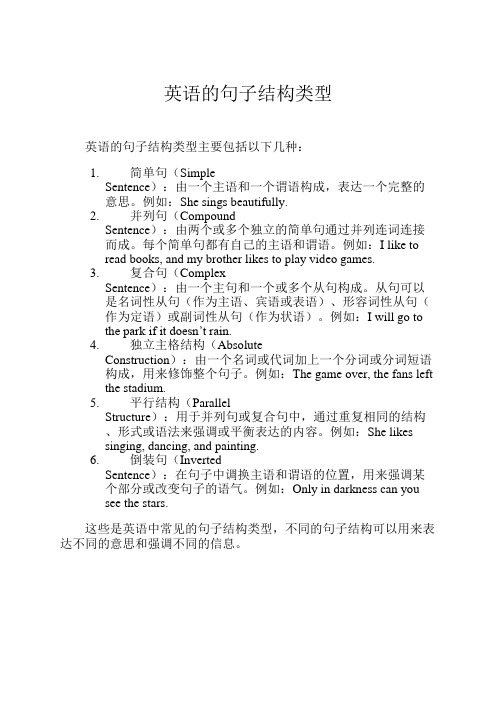
英语的句子结构类型英语的句子结构类型主要包括以下几种:1.简单句(SimpleSentence):由一个主语和一个谓语构成,表达一个完整的意思。
例如:She sings beautifully.2.并列句(CompoundSentence):由两个或多个独立的简单句通过并列连词连接而成。
每个简单句都有自己的主语和谓语。
例如:I like toread books, and my brother likes to play video games.3.复合句(ComplexSentence):由一个主句和一个或多个从句构成。
从句可以是名词性从句(作为主语、宾语或表语)、形容词性从句(作为定语)或副词性从句(作为状语)。
例如:I will go tothe park if it doesn’t rain.4.独立主格结构(AbsoluteConstruction):由一个名词或代词加上一个分词或分词短语构成,用来修饰整个句子。
例如:The game over, the fans leftthe stadium.5.平行结构(ParallelStructure):用于并列句或复合句中,通过重复相同的结构、形式或语法来强调或平衡表达的内容。
例如:She likessinging, dancing, and painting.6.倒装句(InvertedSentence):在句子中调换主语和谓语的位置,用来强调某个部分或改变句子的语气。
例如:Only in darkness can yousee the stars.这些是英语中常见的句子结构类型,不同的句子结构可以用来表达不同的意思和强调不同的信息。
独立主格的句子
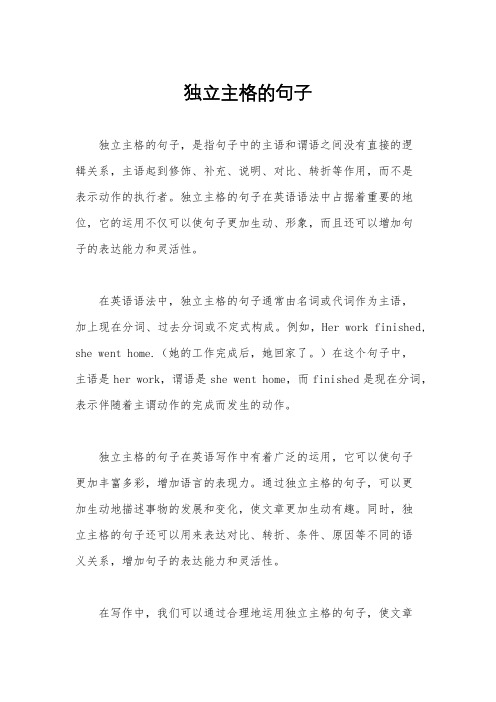
独立主格的句子独立主格的句子,是指句子中的主语和谓语之间没有直接的逻辑关系,主语起到修饰、补充、说明、对比、转折等作用,而不是表示动作的执行者。
独立主格的句子在英语语法中占据着重要的地位,它的运用不仅可以使句子更加生动、形象,而且还可以增加句子的表达能力和灵活性。
在英语语法中,独立主格的句子通常由名词或代词作为主语,加上现在分词、过去分词或不定式构成。
例如,Her work finished, she went home.(她的工作完成后,她回家了。
)在这个句子中,主语是her work,谓语是she went home,而finished是现在分词,表示伴随着主谓动作的完成而发生的动作。
独立主格的句子在英语写作中有着广泛的运用,它可以使句子更加丰富多彩,增加语言的表现力。
通过独立主格的句子,可以更加生动地描述事物的发展和变化,使文章更加生动有趣。
同时,独立主格的句子还可以用来表达对比、转折、条件、原因等不同的语义关系,增加句子的表达能力和灵活性。
在写作中,我们可以通过合理地运用独立主格的句子,使文章更加流畅自然,增加文章的语言美感。
同时,独立主格的句子也可以用来修饰主句,增加句子的表达能力和灵活性。
因此,在写作中,我们应该灵活地运用独立主格的句子,使文章更加生动有趣,增加文章的表现力。
总之,独立主格的句子在英语语法中占据着重要的地位,它的运用不仅可以使句子更加生动、形象,而且还可以增加句子的表达能力和灵活性。
通过合理地运用独立主格的句子,我们可以使文章更加流畅自然,增加文章的语言美感,从而提高文章的质量。
因此,在写作中,我们应该灵活地运用独立主格的句子,使文章更加生动有趣,增加文章的表现力。
独立主格结构的构造方式和句型
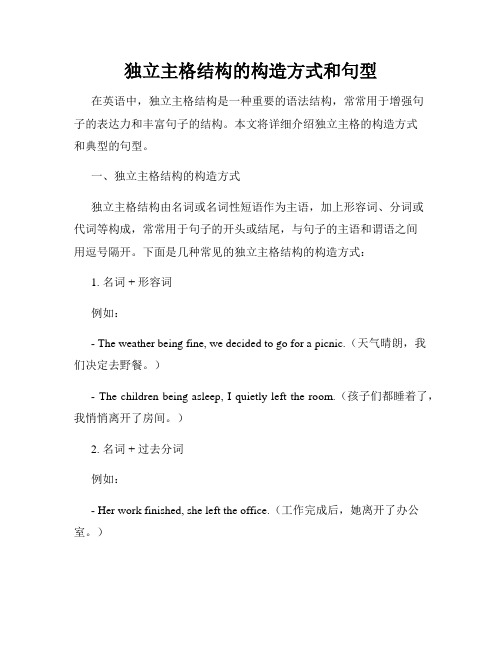
独立主格结构的构造方式和句型在英语中,独立主格结构是一种重要的语法结构,常常用于增强句子的表达力和丰富句子的结构。
本文将详细介绍独立主格的构造方式和典型的句型。
一、独立主格结构的构造方式独立主格结构由名词或名词性短语作为主语,加上形容词、分词或代词等构成,常常用于句子的开头或结尾,与句子的主语和谓语之间用逗号隔开。
下面是几种常见的独立主格结构的构造方式:1. 名词 + 形容词例如:- The weather being fine, we decided to go for a picnic.(天气晴朗,我们决定去野餐。
)- The children being asleep, I quietly left the room.(孩子们都睡着了,我悄悄离开了房间。
)2. 名词 + 过去分词例如:- Her work finished, she left the office.(工作完成后,她离开了办公室。
)- The book read, he returned it to the library.(书读完了,他把它还给了图书馆。
)3. 名词 + 现在分词例如:- The sun shining brightly, we went for a walk.(阳光明媚,我们去散步了。
)- The guests talking loudly, the hostess could hardly hear herself think.(客人们大声交谈,女主人几乎听不到自己的思绪。
)4. 名词 + 不定式例如:- My homework to be done, I couldn't go out to play.(作业还没做完,我不能出去玩。
)- The car to be repaired, he had to take the bus.(汽车需要修理,他不得不坐公交车。
)5. 名词 + 独立代词例如:- John being absent, Mary had to lead the meeting.(由于约翰不在,玛丽不得不主持会议。
英语8独立主格结构
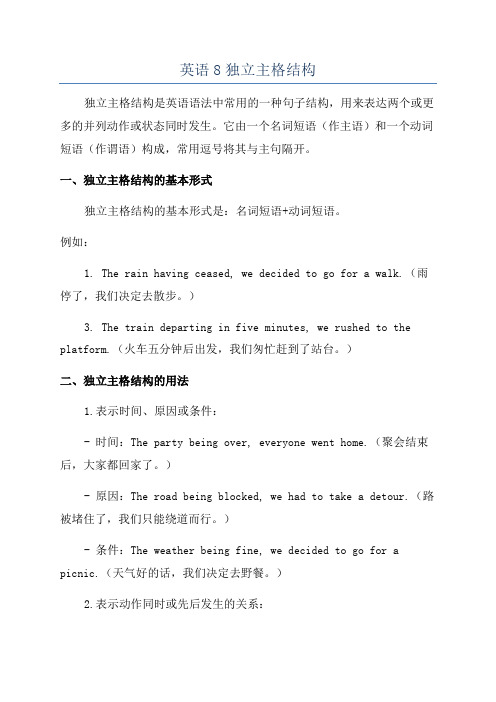
英语8独立主格结构独立主格结构是英语语法中常用的一种句子结构,用来表达两个或更多的并列动作或状态同时发生。
它由一个名词短语(作主语)和一个动词短语(作谓语)构成,常用逗号将其与主句隔开。
一、独立主格结构的基本形式独立主格结构的基本形式是:名词短语+动词短语。
例如:1. The rain having ceased, we decided to go for a walk.(雨停了,我们决定去散步。
)3. The train departing in five minutes, we rushed to the platform.(火车五分钟后出发,我们匆忙赶到了站台。
)二、独立主格结构的用法1.表示时间、原因或条件:- 时间:The party being over, everyone went home.(聚会结束后,大家都回家了。
)- 原因:The road being blocked, we had to take a detour.(路被堵住了,我们只能绕道而行。
)- 条件:The weather being fine, we decided to go for a picnic.(天气好的话,我们决定去野餐。
)2.表示动作同时或先后发生的关系:- 同时发生:The guests chatting and laughing, the party wasin full swing.(客人们聊天和笑声不断,派对热闹非凡。
)- 先后发生:The sun having risen, the villagers began their work.(太阳升起后,村民们开始工作。
)3.表示主次关系:- 明显:The teacher being absent, the students were free.(老师不在,学生们有空。
)- 不明显:His voice being weak, he was not heard by everyone.(他的声音很小,不是每个人都能听到。
独立主格句型:名词 + 现在分词
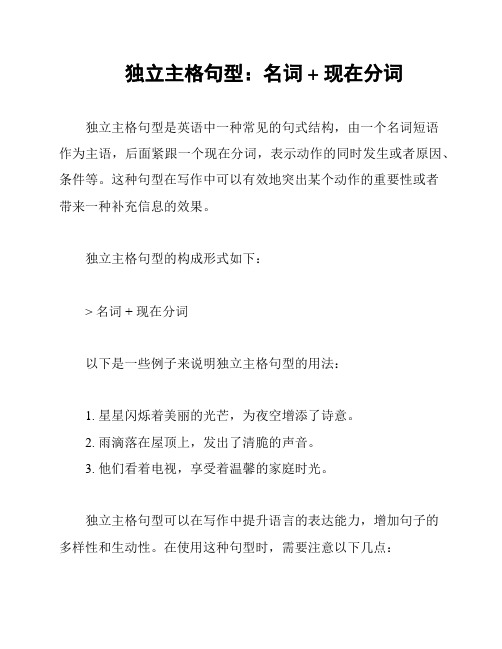
独立主格句型:名词 + 现在分词
独立主格句型是英语中一种常见的句式结构,由一个名词短语
作为主语,后面紧跟一个现在分词,表示动作的同时发生或者原因、条件等。
这种句型在写作中可以有效地突出某个动作的重要性或者
带来一种补充信息的效果。
独立主格句型的构成形式如下:
> 名词 + 现在分词
以下是一些例子来说明独立主格句型的用法:
1. 星星闪烁着美丽的光芒,为夜空增添了诗意。
2. 雨滴落在屋顶上,发出了清脆的声音。
3. 他们看着电视,享受着温馨的家庭时光。
独立主格句型可以在写作中提升语言的表达能力,增加句子的
多样性和生动性。
在使用这种句型时,需要注意以下几点:
1. 确保名词和现在分词之间的逻辑关系清晰,不要造成歧义或混淆。
2. 确保现在分词所修饰的动作与名词之间的逻辑关系正确,不要出现不符合语义的搭配。
3. 不要过分频繁地使用独立主格句型,应该根据具体的语境和需要适度运用。
总之,在使用独立主格句型时,我们应该准确把握其用法,并合理运用,以提升文章的表达效果。
- 1、下载文档前请自行甄别文档内容的完整性,平台不提供额外的编辑、内容补充、找答案等附加服务。
- 2、"仅部分预览"的文档,不可在线预览部分如存在完整性等问题,可反馈申请退款(可完整预览的文档不适用该条件!)。
- 3、如文档侵犯您的权益,请联系客服反馈,我们会尽快为您处理(人工客服工作时间:9:00-18:30)。
独立主格结构独立主格结构(Independent Genitive)有两部分组成,前一部份是或者代词,后一部分是非(不定式、动名词和)或形容词、、或介词短语。
前后两部分具有逻辑主谓关系。
独立主格结构在句中做状语,多用于书面语。
独立主格结构本身不是句子,在句子中作状语,表示时间、原因、条件、伴随、目的等。
详细概述非谓语动词作状语,其逻辑须与主句主语保持一致。
若不一致,非谓语动词形式须另带主语,从而构成复合结构的形式作状语。
这种结构称为“独立结构”。
其中,非谓语动词主动用V-ing,被动用V-ed。
非谓语动词及其短语前面带有逻辑主语,逻辑主语的又是主格,故常称为“独立主格”。
“独立结构”在句中起状语作用,相当于状语从句,表示时间、原因、条件、方式或伴随等情况。
功能独立主格结构主要用于描绘性文字中,其作用相当于一个,常用来表示时间、原因、条件、行为方式或伴随情况等。
例如:表示时间The meeting being over, all of us went home. 开完会后我们都回家了。
Her work done, she sat down for a cup of tea. 她干完了活,坐下来喝茶。
表示条件The condition being favourable, he may succeed. 若条件有利,他或许能成功。
表示原因There being no taxes, we had to walk. 没有出租车,我们只好步行。
He wrapped her up with great care, the night being dark and frosty. 夜又黑又冷,所以他把她裹得严严实实的。
表示伴随情况Almost all metals are good conductors, silver being the best of all. 几乎所有的金属都是良导体,而银则是最好的导体。
(=Almost all metals are good conductors, and silver is the best of all.)用法独立主格结构主要表示发生的时间、原因、条件或伴随情况等,相当于一个状语从句或并列句。
用作时间状语The work done(=After the work had been done), we went home. 工作完成后,我们就回家了。
用作条件状语Weather permitting(=If weather permits), they will go on an outing to the beach tomorrow. 如果天气允许的话,他们将在明天组织一次海滨小游。
用作原因状语An important lecture to be given tomorrow(=As an important lecture will be given tomorrow), the professor has to stay up late into the night. 因为明天要发表一个重要的演讲,教授不得不熬夜到很晚。
用作伴随状语He was lying on the grass,his hands crossed under his head(=and his hands were crossed under his head).他躺在草地上,两手交叉枕在脑后。
表示补充说明We redoubled our efforts, each man working like two. 我们加倍努力,一个人干两个人的活。
*注:独立主格结构表示时间、条件或原因时,相当于一个状语从句,一般放在句首,表示原因时还可放在句末;表伴随状况或补充说明时,相当于一个并列句,通常放于句末。
形式1>一般独立主格形式:与主句逻辑关系松散形式为: n. + -ed/-ing形式; n. + 不定式 ; n. + ; n. + ; n. + 副词. ;名词/主格代词+现在分词名词/主格代词与之间是主谓关系。
如:The girl staring at him(= As the girl stared at him), he didn't know what to say. 姑娘两眼望着他,他不知道说什么好。
Time permitting(= If time permits), we will go for an outing tomorrow. 如果时间允许的话,我们明天去郊游。
名词/主格代词+过去分词名词/主格代词与过去分词之间是动宾关系。
如:The problems solved(= As the problems were solved), the quality has been improved. 随着问题的解决,质量已经提高了。
Her glasses broken(= Because her glasses were broken), she couldn't see the words on the blackboard. 由于眼镜摔坏了,她看不见黑板上的字。
名词/主格代词+不定式名词/主格代词与不定式之间是主谓关系,且强调的是一次具体性的动作。
如:He is going to make a model plane, some old parts to help. 借助于一些旧零件,他要做一个飞机模型。
They said good-bye to each other, one to go home, the other to go to the bookstore. 他们道别后,一个回了家,一个去了书店。
名词/主格代词+形容词如:An air accident happened to the plane,nobody alive. 那架飞机遭遇了空难,无一人生还。
So many people absent, the meeting had to be called off. 这么多人缺席,会议不得不取消。
名词/主格代词+副词如:He put on his sweater ,wrong side out. 他把毛衣穿反了。
The meeting over, they all went home. 会议一结束,他们就都回家了。
名词/主格代词+介词短语如:The boy goes to the classroom,book in hand. 那男孩手里拿着书去教室。
Mary was sitting near the fire, her back towards the door. 靠近火炉坐着,背对着门。
2>with 引导的独立主格:与主句逻辑关系紧密形式为: with + n. + -ed/-ing形式; with + n. +abj.; with +n. + 介词短语3>each引导的强调型独立主格:尾的复数名词形式为:句子 + 复数名词结尾 , each + 介词短语/形容词短语/名词短语/-ing形式/-ed形式如:Under the restructuring, the huge organization that operates the company's basic businesses will be divided into five groups, each with its own executive.(题源:《GMAT 语法全解》着,Page38)4>其他形式There being +名词(代词)如:There being nothing else to do, we went home. 没有别的事可做,我们就回家了。
There being no further business, I declare the meeting closed. 没有再要讨论的事了,我宣布散会。
It being +名词(代词)如:It being Christmas, the government offices were closed. 由于圣诞节的缘故,政府机关都休息。
It being a holiday, all the shops were shut. 由于今天是,所有商店都关门了。
特点1)独立主格结构的与句子的主语不同,它独立存在。
2)名词或代词与后面的,形容词,副词,不定式,等是主谓关系。
3)独立主格结构一般有逗号与主句分开。
举例:The test finished, we began our holiday.= When the test was finished, we began our holiday.考试结束了,我们开始放假。
The president assassinated, the whole country was in deep sorrow.= After the president was assassinated, the whole country was in deep sorrow.总统被谋杀了,举国上下沉浸在悲哀之中。
Weather permitting, we are going to visit you tomorrow.如果天气允许,我们明天去看你。
This done, we went home.工作完成后,我们才回家。
The meeting gone over, everyone tired to go home earlier.会议结束后,每个人都想早点回家。
He came into the room,his ears red with cold.他回到了房子里,耳朵冻坏了。
He came out of the library, a large book under his arm.他夹着本厚书,走出了图书馆注:独立主格结构有时可在其前加上介词with。
如:Don’t sleep with the windows open.别开着窗睡觉。
He was lying on the bed with all his clothes on.他和衣躺在床上。
She came in with a book in her hand.她手里拿着一本书走了进来。
He fell asleep with the lamp burning.他没熄灯就睡着了。
I won’t be able to go on holiday with my mother being il因为妈妈有病,我无法去度假。
He sat there with his eyes closed.他闭目坐在那儿。
